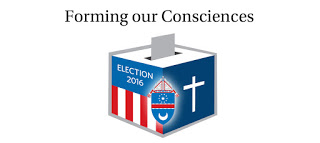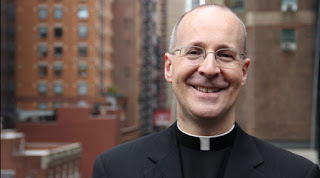

| Online: | |
| Visits: | |
| Stories: |

| Story Views | |
| Now: | |
| Last Hour: | |
| Last 24 Hours: | |
| Total: | |
Vote With Your Informed Conscience: Catholics and the Election of 2016
A brief analysis of Forming Consciences for Faithful Citizenship (FCFC) can demonstrate why Catholics often advise one another to form their consciences on voting (and other matters). The Church will not, indeed, it cannot, it is said, tell Catholics exactly how to vote. Political life is too messy and the Christian message cannot be realized in a single party’s platform. “Unfortunately, politics in our country often can be a contest of power interests, partisan attacks, sound bites, and media hype,” FCFC explains. Therefore, it concludes, “The Church calls for a different kind of political engagement: one shaped by the moral convictions of well-formed consciences and focused on the dignity of every human being.” When the dint of democratic politics renders The Good unclear, and The Truth is obscured, the Catholic Church provides moral resources so the individual can form their own consciences. According to this notion, the Catholic Church does not explicitly command, rather, it sets a moral context in which individual Catholics can form their own consciences. It then is up to the individual to improve the subjective dimension of moral life (conscience) by forming the conscience with a variety of objective Church teachings (laws). “The Church equips its members to address political and social questions by helping them to develop a well formed conscience,” the document explains, adding that “The formation of conscience includes several elements.” These elements include prayer, reading the Catechism, diving into Scripture, and studying the particular political situation. One undertakes all of these activities of reading and prayer to form their own consciences. Conscience brings the subjective aspect moral life (conscience) into reciprocating relationship with the objective benchmarks of moral life (laws); Truth, then, can be clearly apprehended.
The notion of the informed conscience has a long history in American Catholic life but it has come recently to occupy an important place in political theology, particularly as it pertains to the concrete act of voting. During the summer and fall of 2016, advice to vote with an informed conscience echoed across the United States. Catholics, for example, referenced Forming Conscience for Faithful Citizenship frequently throughout the campaign season. The advice also appeared in popular Catholic media. Jesuit James Martin advised Catholics in a YouTube video posted on November 6 to follow informed consciences when punching their tickets. “The Church forms consciences, it doesn’t dictate them,” Martin assured. Thus, the Catholic Church had a duty – and a strategy – to help Catholics form their consciences. The advice resounded from Catholic pulpits across America. Homilies and pastoral letters hailed from priests and bishops in Pennsylvania, Colorado, New York, and North Dakota, entreating the voting faithful to form and follow conscience on November 8.
Jim Martin attended mass at his mother’s parish in suburban Philadelphia just two days before Election Day where the local priest instructed him and everybody else in the pews to vote with an informed conscience. At the end of the mass, Martin explained, the presiding priest told the congregation that “we have an important day coming up on Tuesday, Election Day, so please use your informed consciences and vote.” Martin, a in a YouTube video for his many Facebook followers, deemed this advice “perfect.” He noted that the Church cannot and should not endorse a particular candidate or a specific platform. The Catholic Church, he explained, needs to maintain its freedom. Martin mentioned a broad array of teachings for the individual to consider when forming a conscience: the teachings included, he noted, life issues (abortion, euthanasia, the death penalty), poverty, migration, homelessness, income inequalities, justice, war, and peace. Martin then defined the informed conscience as “a conscience that understands the Gospels and Church teachings.” He assured his audience that they will be making a good decision if they vote with informed consciences.
Martin has a rather capacious understanding of the formation of conscience. But many Catholic authorities made clear that the objective teaching on the protection of innocent human life was the most important Catholic tenet to consider as one formed a conscience. Bishop John D. Conley of Denver gave a long-winded address entitled “Forming One’s Conscience in Preparation for Voting” at a seminar on faithful Catholic citizenship in Denver, Colorado, where he made the point that life issues were paramount in conscience-formation. Conley explained at length why Catholics formed their own consciences (the church cannot tell you how to vote) – but he emphasized that teachings on life mattered above all others as it pertained to conscience-formation. “This … sanctity of the human person who is created in the image and likeness of God, is really at the heart of all Catholic social and moral teaching,” he wrote, adding that, “And it is based on this doctrine of the human person that we shape and form our consciences….” Thus, he reasoned, a properly formed conscience could not lead a Catholic to vote for a pro-choice candidate. The tilt to this “objective teaching” could be subtle but its influence is unmistakable. Bishop Kagan of Bismark, North Dakota, wrote a pastoral letter to this diocese explaining that Church teachings are “the means for us to properly form our consciences so that we seek always what is true and good.” Teachings on abortion and euthanasia, he added, are the most important teachings to consider when forming a conscience. “In the context of the political process, forming our conscience takes place when we seriously examine the issues and are open to the truth and what is right according to Catholic teaching,” Bishop Robert Gruss told his South Dakota flock. He went on to explain that protection of innocent life is at the top of the hierarchy in Catholic Social Teaching.
Historians of religion, like other scholars, should answer the call to explain the election of Donald J. Trump. Initial reports show that 60% of white Catholics cast their ballot in favor the former reality TV star. Doubtless, economic concerns — along with a range of other variables — mattered to the faithful. This blog post wants to suggest that the strong emphasis on the formation of conscience played a role in helping Catholics to vote for Trump. As a historian of religion, I am inclined to consider both the material and metaphysical realities of the people we study. Catholics have pursued the theology historically to deal with the challenges of balancing objective truth (laws) and the ontological reality of person’s subjective nature (conscience). Indeed, as the documents point out, one does not simply bring people to truth by coercion; they must help others craft their consciences – a self-directed exercise – with a range of available teachings. Yet the election of 2016 exposed the weakness of this theological “way of seeing.” As Catholics were asked to consider a ballast of objective and subjective it obscured many particular aspects about the winner of the election. Perhaps church men and women can now begin reconstructing a Catholic theology of voting.
FCFC, 12.
Ibid., 14-15.
James Martin, YouTube, November 6, 2016. Link found here: https://www.facebook.com/FrJamesMartin/videos/10153909228076496/?pnref=story
Ibid.
Ibid.
Conley, “Forming One’s Conscience In Preparation for Voting,” Southern Nebraska Register. http://www.lincolndiocese.org/op-ed/bcwriting/112-forming-one-s-conscience-in-preparation-for-voting
“Bishop of Bismark Clarifies Voting Obligations for Catholics,” Catholic Action for Faith and Family. http://www.catholicaction.org/bishop_of_bismark_clarifies_voting_obligations_for_catholics
Robert D. Gruss, “Our Country is Facing Political Challenges,” http://rapidcitydiocese.org/our-country-is-facing-political-challenges/
PEW Research, “How the Faithful Voted: A Preliminary Analysis,” http://www.pewresearch.org/fact-tank/2016/11/09/how-the-faithful-voted-a-preliminary-2016-analysis/
A Group Blog on American Religious History and Culture
Source: http://usreligion.blogspot.com/2017/02/vote-with-your-informed-conscience.html




